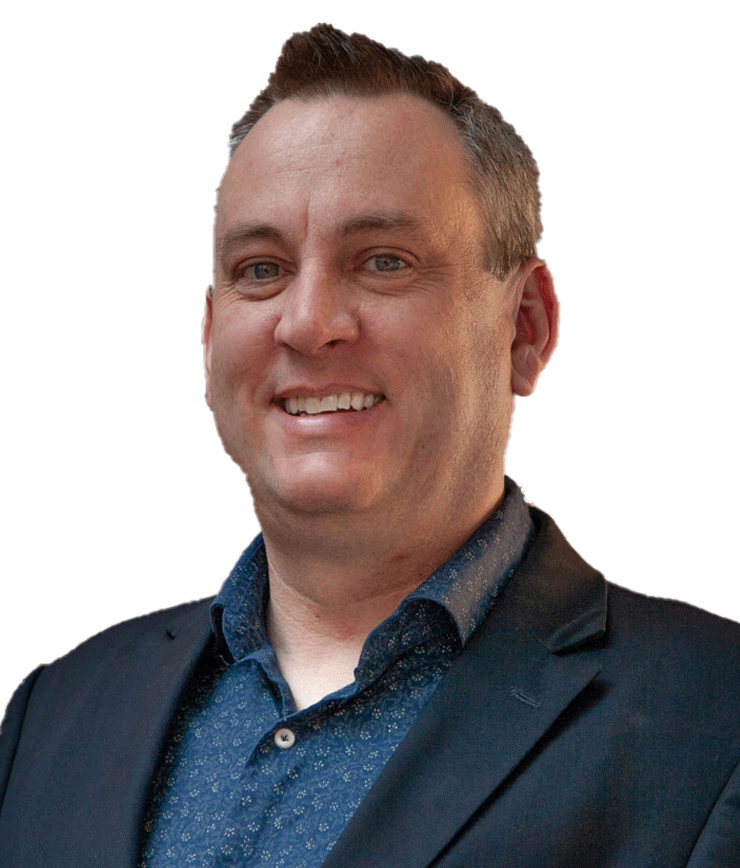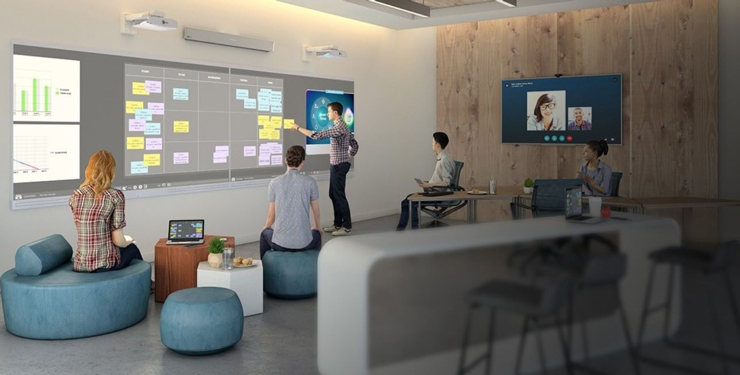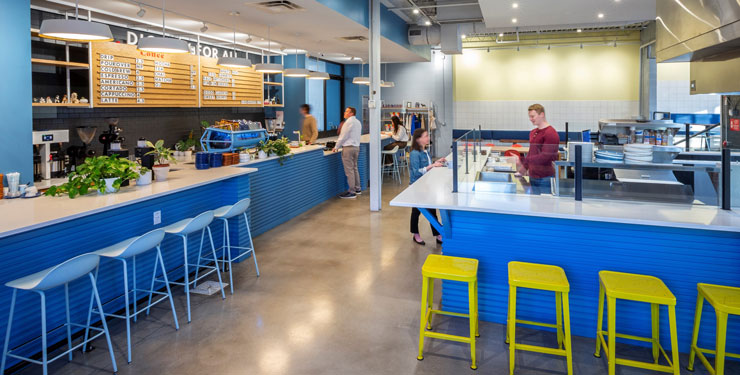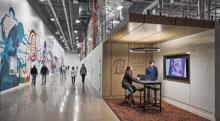
Where Science, Happiness, and Design Intersect
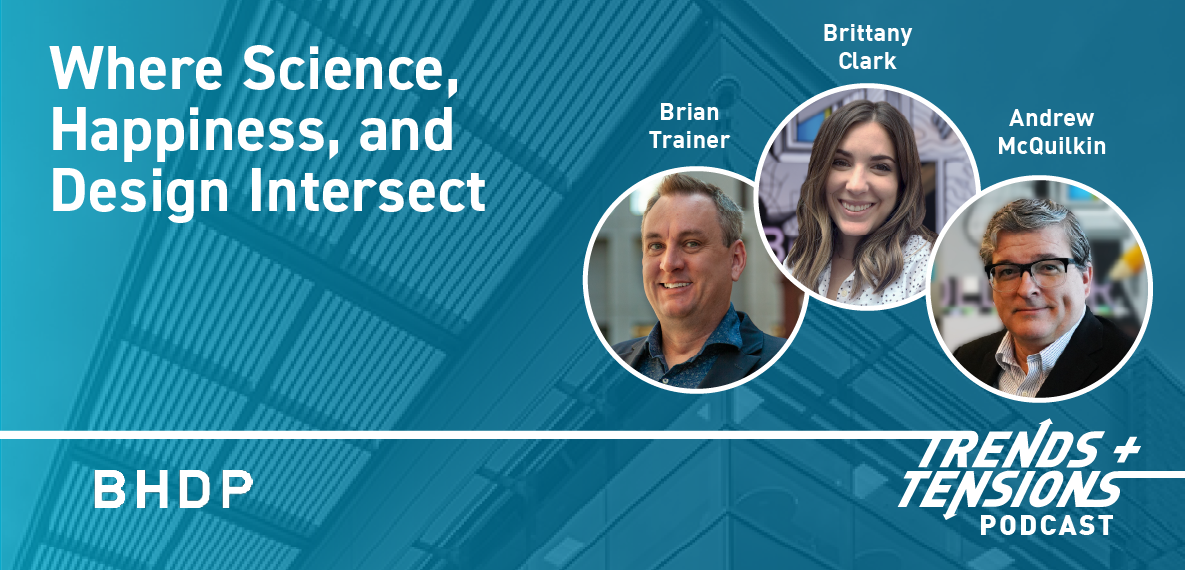
Want to listen on another platform? Choose your platform here.
Episode Transcript
[Music Intro]
Brian Trainer, Host: Welcome to Trends + Tensions presented by BHDP, where we discuss trends in architectural and interior design and the competing priorities or tensions that arise from integrating new ideas into existing organizations, enterprises, and institutions. In this episode, “Where Science, Happiness, and Design Intersect,” we bring in BHDP’s Andrew McQuilkin, Design Leader, and Brittany Clark, Interior Designer, to talk about the science behind happiness and how it can shape the future of our design. I'm your host, Brian Trainer, Senior Strategist for BHDP. Let's get started.
Brian: On Trends + Tensions, today we're going to be talking about designing for happiness. So, what is happiness? And why should employers care if their employees are happy or not?
Brittany Clark: Happiness is defined as a positive and or pleasant emotion ranging from contentment to intense joy. Moments of happiness may be triggered by positive life experiences or memories. So, in terms of, you know, employers being concerned about happiness, happier employees are more likely to stay at a company. And also, they're going to not only perform better but just in terms of their wellness, that will also be better in the long run as well. So happier people equal healthier people as well.
Brian: Yeah, Andrew, do you want to add anything to Brittany's fine kickstart there?
Andrew McQuilkin: I think too, you know, happy people are more productive people. They learn better when they're happy. They develop faster when they're happy. And you're going to have more success as a happier person, you would hope.
Brian: Yeah, I did something this weekend where I was working at one point, I'm like, that was 10 hours already? You know, it was just that I was having so much fun. I didn't realize that I was working. Yet, my father came from the old-school way of, you know, just put your head down to do your work. And it's like, why do we care about happiness? And you made the case that it's like happier workers are more productive.
Brittany: Well, it even goes back to like my dad always used to say, if you enjoy what you do, you'll never have to work a day in your life.
Brian: Yeah, I’ve heard that.
Brittany: It kind of goes along with that as well.
Brian: Sure. But what made you decide to investigate this in the first place? Like, how did you go down the happiness path?
Andrew: Well, last year, Brittany and I were researching anxiety and trying to understand how planning and design help this anxiety epidemic that we're having, you know, certainly post COVID, it's gotten even worse. And so, as we went a little deeper, we said, okay, here's the design and planning things we could do. But then, as we went into this year, we started thinking about that was the negative side that we could do. What are the positive things that are going to make people happy so that you can get out in front of it. And the other thing, too, from working with a lot of leadership within the organizations that we work for, whether it's retailers, or workplaces, or ID, or students with higher ed, you end up getting top leadership can have all the vision in the world, like really big ideas. But what the top leadership will realize is it comes down to people. If I can't inspire or make my people happy, I'm never going to fulfill the vision and success that we're trying to get to. So that for me has always been a big thing out there for us. And so, we've talked about and said, let's delve into happiness. And we went pretty deep.
Brittany: Especially since, at BHDP, we always say we design for people. So, it really just came down to how are we supposed to design for people if we don't understand people? Even just putting ourselves in people's shoes, just kind of understanding, we do that already just with our clients. But it really just went back down to that primal brain of how our brains react to certain things anyways and trying to understand who people are at the base of, you know, the human.
Brian: How do people, people?
Brittany: And we're trying to figure that out, right? We can't design a space for somebody if we don't understand them. But also, we can't design for them, if we don't understand how the brain reacts to certain things.
Brian: How do we start a conversation about happiness?
Andrew: It's interesting. When we work with our clients, and we start to develop success criteria with them, we will sit in a visioning session for half a day or more. And you'll start to see things that come out in terms of criteria and goals that they have. And when they're really people-related goals, to inspire people to get to those goals, we can have the conversation around, well, what is your issue? Usually, it's the negative like, what is the problem? Well, retention is one of our problems. Well, why is retention problem? Because people are not happy. Well, why are they not happy? And then go deeper into it. Well, what can we do then? To attach and try to understand behaviors around those people through planning and design to get to those goals. So, we've always been doing this for years. We've been doing the common sense version of it, trying to understand that if you make a space that really doesn't function for the work process, the serotonin is not going to be released. They're going to be really unhappy. And they're going to rebel against that, right? We do a lot of move the cheese stuff that happens within space when the leadership wants to change the way they do things. And the first time it shows up is when they go into the new space. Well, we do a lot of change management in our work to make sure that people have input who are going to use these spaces, but then we can adapt their thinking around the space, get management more engaged to demonstrate how a space works so that people then can adapt quicker, and not be as frustrated. Knowing that in the end, it's going to make them more productive because they're happier.
Brian: Can happiness be measured? Like, how are we measuring whether or not people are happy? In the workplace or not? You've established success criteria. We know we want to do something about it. What are you looking for? What are you measuring?
Andrew: Well, again, depending on the market that we're in, like if you're in retail sales, that's one of the biggest things that determine if your customers are happy with the product, and the experience of buying within that space. When we talk about workplace, a lot of great workplaces do surveys every year. They survey their teams. And there will always be things that come out of it like level of engagement, right? They're getting criticized for that. They always concentrate on the negative. But again, if level of engagement is something that's making them unhappy, how do we design a space that allows for more collaboration and more engagement? There is actually going to be a hormone attached to that is going to make people form stronger relationships and bonds to the people they work with, and in that case, also with the company. So, there are ways to measure it. Usually, it's through surveys or the negative of retention. Turnover is a symptom of people being unhappy.
Brian: I remember taking a survey in one of my first jobs way back in the 90s. There was a question that said, “Others create unnecessary work for me.” It was like a yes or no. I've never had that question asked again. It was one of those where there is friction at work created by other people in the way they do their jobs and such.
Andrew: But do they make your job easier? We should always strive to make our other teammates’ jobs easier. Another happiness score that's out there, like think about you go to Google, and you look up a restaurant. There are stars that represent the experience level that people have within the space, and then you can go through the comments. In the marketing world, they have what they call an NPS score. An NPS score is looking at “would you recommend this experience or this brand to someone else?” It's really viable in the marketing world. Well, it's rolled into retail, and now it's rolling into other markets within our businesses where their heads of marketing for these corporations are looking at, “would people recommend people to work here?” And that's a really good tell.
Brittany: It's like a Glassdoor for workplace environments.
Brian: So, knowing that happiness can be measured and using it as a success criteria, where does happiness intersect with design? How do you design for happiness?
Brittany: So, I think it comes down to, like I mentioned before, kind of this primal brain, but also at BHDP, just using some of the tools that we have, kind of in our back pocket anyways. So, a lot of that, as I've mentioned, is understanding the client and kind of who we're designing for. One of the tools that we have is kind of that “day in the life.” Understanding how they typically work before we come into the scenario, and then once we do, how we can improve on those efficiencies and also help address those aspects that could make them happier. For instance, if they are a call center and they're on hard calls all the time, having those respite rooms for them to get off the phone, and go into those rooms and resettle and have that respite area. Keeping in mind the tools that we have and planning for those, but also, again, the primal brain. So, there are things that we registered anyway. And a lot of it goes back to our ancestors and what we define as being suitable and kind of what makes us happy. Psychologists have proven that the Savannah is actually what we consider to be the best place, and everyone should try to design for that. So, that meaning is creating spaces that have that variety, but also kind of those nooks that you can hide in and also being able to see everything. If you're standing in one area of that floorplan, being able to see the different zones that you would need to pop in throughout that day for you.
Brian: It's interesting you bring up the primal brain because I know there's some science behind this as well. The thing that I'm curious about, so the aspects of the Savannah are the most secure. You’re talking about places to hide, but still being able to see everything. What about the cave-dwelling animals? Like, we're designing for a group of engineers, they tend to like not seeing anything. Is that a different type of happiness you have to design for?
Brittany: With happiness, there's no one-size-fits-all kind of approach. So, again, designing for the specific client that we are working with, but also there are just things, so even though someone might lean more towards being in a private room by themselves, they do kind of want that social interaction. It just might come in different scenarios. So, it could be those impromptu connection points, meaning it could be like at the copy and print, so you go and get a copy, you might pass somebody, or it might be in the break room, you might pass somebody, and that might be enough. So, it's really understanding who that client is and how we can better their interactions throughout the day.
Brian: When I think about workplace, and now that I've got Savannah as an analogy, I'm imagining most workplaces are designed for tigers, the hunters, the people out there doing those things, but there's also meerkats. We need to hide sometimes, you know what I mean? So, you're saying enclosed rooms are like the respite spaces or things like that?
Brittany: That's creating that variety. Yeah, having that open and then also having the enclosed spaces that you can go in and hide.
Andrew: So, I think there's a piece to hybrid work. They're trying to bring people back to the office. Some places, I heard that once a pay period, they're having people come back, or three days a week, you know, it's probably more than typical. But if you're going to come back to the office, you need to give people a reason. It isn't about necessarily, I think, as much your team and your location that is that you have a set space. It's "what's the activity that I need to do today that's going to bring me to the office and will the office function in a way that's going to, you know, satisfy what I'm trying to get done?" So, I can have the gratification that I got my work done because I showed up. So, let's just say you're home and you've got a bunch of kids at home that are being homeschooled. Sometimes, coming into the office is when you need the quiet space to get the heads-down work done, right? But, it may be that you need the connections. You need to come to the office and engage people to be able to feel satisfied that you were able to build loyalty and friendship and associate it with space. So, I think part of the hybrid work model that I've seen out there now is it's not necessarily departmental, as much as it is, what do I need to get done? And does the space help me do that? And again, a functioning space makes you happy. But, if we can add all the other things that we've talked about, the primal stuff like natural daylight, you feel good in these spaces.
Brian: Now, that makes a lot of sense. So, can you talk about the science behind happiness a little bit?
Andrew: As we went deeper, I was actually at a healthcare experience conference, and one of the speakers started talking about a thing called DOSE, D-O-S-E. I'm like, What's the DOSE? It was the shorthand for dopamine, oxytocin, serotonin, and endorphins. They were talking about website navigation. Depending on the problem and the feedback that we're getting through the customer surveys, you could apply the appropriate hormone release to help them get past their frustration or be able to be happy and satisfied with that online experience. I said, “wait, we kind of do that already common sense-wise through design.” So, why don't we go deeper and try to understand the effects of these four hormones, where we would apply them, and what releases them. But a lot of the releases happen through environmental factors or sensory perceptions; well, wait, that can be designed. So, how do we then figure out what design elements would then release those? So, I think part of it is an understanding the success criteria and goals of a client and the problems and obstacles they're having. Maybe we can apply the right hormone release at the right time in space so that we can have happier employees.
Brian: Have you explored ways to do that then? Do you have any thoughts on how, like, how do you make dopamine happen in space?
Andrew: Dopamine, they call it by the way, the happiness chemical. It's the one most directly related, but it's really a reward chemical for happiness. Part of it's about more the anticipation than the actual reward. So, I originally was saying, surprise and delight, right? But if you have a moment that surprises you, there's a release of dopamine. But if you anticipate that it's going to happen again. They did a study on rats, of all things, that measured their happiness hormone. And it was actually if there was a randomized release of reward, their anticipation levels of dopamine were higher than the actual reward over time. And so long as they were randomized that, it would get higher and higher. Think of gambling. So, you can get addicted. If they standardized it, and you knew at two o'clock every day, the same reward was going to happen. You kind of get used to it. In fact, you feel entitled to it, and there's no more release. So, I think in space, we have to think about what is the surprise and delight that we're going to offer to a real experience, a spatial experience. We thought about certain design elements that would go with that. That basically you could think about compression and expansion. Frank Lloyd Wright would love to pull you in and then surprise you with a space that's grandiose, that opens up, you’re the cadence of elements. You don't want to have to necessarily anticipate that there's always going to be the same thing at every floor, or every moment. You can randomize it to say: okay, you turn a corner what, wow! That's really interesting, right? You didn't anticipate it. But then you get usedhat there will always be some surprise coming, but you just don't know when. And that's when you're going to be happy about it when that happens. And then we talked about things that release dopamine, like quiet rooms, right? So, like for your introverts, that's something where they just need that respite to kind of regain, but dopamine relaxes them, and makes them happy at the same time. Active exercise, so when we talk about wellness and active spaces, getting the team to use staircases is actually good for them and makes them happy. There are all these things that you can associate with each of these hormones. So, we went pretty deep and said: “okay, well, if it's something about, you know, the way that you want to build loyalty to somebody and build that kind of happiness. That randomization is really going to be something that's going to build loyalty to your brand and the people in the team that's there.”
Brian: I understand that surprise and delight is one of the 14 design elements of biophilic design. Are there other existing design concepts that you can pull from that feed into these? Or are we creating a whole new language around design for happiness?
Andrew: I think there's basic commonsense stuff that we all know, certainly, for doing design thinking, so not screwing it up. Right? Don't mess it up because you are going to frustrate people. But I think biophilia, which is a newer term, is like natural palates and natural elements. There was a study done by a guru, so it's not necessarily scientific, that she basically turned around and figured out that if it's anywhere from 20% to 40% of biophilic in the visual of what you're seeing, that's going to boost your mood and some of the hormones that are associated with biophilia. Biophilia; actually affects three of the hormones. The idea is that we want to build warmth in neutral palettes. You don't have to do it everywhere. You don't have to be Rainforest Cafe. But it just has to have those moments and then that surprise and delight piece of it, you turn a corner, and there's this beautiful, flowery green wall. So, I think that's some of the things that are out there. Like, I've known for a long time, there was a study done for hospitals on why some patients were recovering and healing faster. One of these hormones is associated with healing, and they found out the biophilia of flowers. If you bring flowers to the room, those people are actually having quicker outcomes, getting out of there sooner. Then they even found out pictures of flowers had the same exact effect. So, we don't have to spend a lot of money to actually leverage this commonsense approach to making people happy.
Brian: We had a co op that did research here on pro-social behaviors. And there was research that was done where there were two streets in England that were almost identical, except one had more trees than the other. And they found that the people that lived on the street with more trees had less pharmaceutical needs regarding mental health. So, they were happier. Basically, they weren't as depressed as the people on the street with no trees. So, you said Biophilia impacts three of the chemicals. Which one does it not?
Andrew: Serotonin, serotonin was the only one that's actually manufactured in your gut. We were talking about it more as like a foundational, truly primal hormone. So, it's affected a lot by food, but also your energy levels, your adrenaline levels. So like, if you get scared or super excited, you get nauseous because serotonin is being released in your stomach. Serotonin is actually the chemical that makes you also puke, but most people feel better after they puke because their chemical balance is better. They call it the confidence molecule. Okay, so if you have really good gut health, you have the confidence to tackle anything. So, I think it's foundational because if you don't have it, you can't do any of the other things that you would want to do or be happy. So, if your tummies not feeling well, you're not going to be successful or be able to do anything you want to accomplish.
Brittany: Also, though, and that's associated with having that gut feeling, so if your gut feels a little off, that's your serotonin.
Brian: Is that your body trying to tell you something's wrong? And does that go back to your primal brain?
Brittany: Yeah, it's regulating your mood. So, if your gut is saying you have a feeling about something, your serotonin in your brain is trying to tell you like, “hey, something is about to happen here.”
Brian: So, you talked about the gut feeling? Is there anything in the research that surprised you?
Brittany: This is something that's new to us in terms of the research, but at BHDP we're already doing this. So, out of all the tools that we have developed, again, it's that common sense. We're developing a space that's based off of how we work, but there's research behind it, so we're not completely making it up. There's science behind this. And I think what was surprising is that it's reinforced in psychology.
Andrew: I will not necessarily find a way to put the science in front of a client. We've developed tools that become visual representations of the science so that we can talk about a sensory experience. And that sensory experience has the science behind it not just on, you know, these chemicals, but other science stuff that basically talks about the effect of your perceptions on how you take on your role. There's a lot of it involved in retail to talk about, you know, what inspires you to shop and buy, or stay longer and buy more. So, applying those has always been there, but to be in front of a client and start talking about dopamine, I'm probably going to lose them. But if I talk about people, and I'm with leadership, they get it. They understand that by putting ourselves in their shoes, that's their job every day to inspire their teams to be able to get to the results they're looking for, like I said earlier. So, you know, we've been doing it, but we went deeper to kind of validate what we already knew and to learn a few things along the way. Like we said, we were surprised. The idea that endorphins, actually are the precursor for dopamine. So, you kind of need endorphins to make dopamine happen. So, if we're going to turn around and inspire people, get them inspired, well, then the surprise and delight stuff is going to work even more.
Brittany: In terms of endorphins, as well, endorphins is used to mask pain, which we don't think. It is associated with exercise and the things that are supposed to make us feel better. But what it is is actually built in our body to mask pain and discomfort. So, when we're releasing endorphins, it, again, masks that pain that we're not even thinking about. We're just thinking it's supposed to be good for our bodies.
Brian: So, is that something that can be designed for? Are endorphins harder to design for than the others?
Andrew: I would think serotonin is the harder one because it's not visually presented. The other three are looking at sensory perceptions. The gut one of serotonin, to build your confidence, you know, that one's a little harder. You're kind of adding things. Like, we've figured out a few things that could help build and then release serotonin. So, whether it's, you know, exercise, whether it’s fitness, fitness spaces, natural daylight (by the way, is the one that's common across all of them), outside access, yoga therapy, quiet rooms. We talk about events, but if you have events that make people happy in space, and there's a memory associated with it, and you put photos or digitals of those events, and people see themselves with the friends that they have at work, it releases serotonin, which is really unknown. To me, that's kind of interesting. So, there is a visual aspect, but it's not about as much design and planning as it is about memory.
Brian: What other things would you like people to know about designing for happiness?
Andrew: I think by creating for BHDP a design thinking methodology or the BHDP design process, we realized that we're going to take the business strategy of our client by understanding the people that are in their space, and what drives them. We were then going to create planning and design solutions that marry the two. That, I think, is a real big communication of, we're the ones who are going to advocate for the user, probably more than anybody, but we're not going to forget about the business strategy of our clients. I think that’s kind of what we want to realize that we can do things that make people happy. Beautiful architecture makes people happy, but that's only a small portion of what we do in terms of design. We really can help people get that inspiration they need to deliver on the strategic goals.
Brian: So how do you give everyone the confidence molecule?
Brittany: I mean, everyone's different in terms of what makes them confident. So, someone might want to hide in the room all day and feel confident.
Brian: Yeah. checking off tasks from a list: confident. Feeling like people think you're smart when you talk: confidence.
Andrew: Putting yogurt in the vending machine, gut health is happy health.
Brian: Really, so literally, you can just give somebody a good gut biome, and it will help increase their confidence?
Andrew: Yeah, if you're not feeling problems in your gut, you are more confident.
Brittany: What is going to make you feel better, right? Confidence is all about feeling good. So, whatever is going to make you feel good. If you're feeling sick that day, you're not going to feel confident in really anything you do.
Brian: That’s true. Interesting.
Andrew: But again, food, music. These are things that we don't normally talk about in design. That’s part of the sensory experience that makes people happy. One of the ones I've always talked about is smell. Right? But smell is so subjective. It's the closest thing tied to your memories. So, if you want to bring up memories of people or experiences, then you want to release endorphins around that.
Brittany: So again, it goes back to there's no one size fits all, but it's trying to design with these elements in mind that we can better the users in general.
Brian: So, you can impact as many as possible, knowing that there is no perfect answer. Very cool. Brittany, thank you. I hope you enjoyed your first time. Andrew, thank you again for coming back, as always. This is fascinating. Anything else? Any final thoughts before we go on?
Andrew: I'm excited to figure out what we're going to do next. We could get caught in a rabbit hole here and go really deep. But how do we simplify it and bring it back, so that our teams can help our clients and their people, you know, move their business forward.
Brittany: So, what he’s saying is stay tuned.
Brian: That's a perfect place to end, thank you.
Brian: Thank you for joining Trends + Tensions presented by BHDP for this episode, “Where Science Happiness and Design Intersect,” with BHDP’s Andrew McQuilkin and Brittany Clark. If you appreciate what you've heard, please rate, subscribe, and give us a review. I am Brian Trainer, your host, and I hope you'll join us for another episode of Trends + Tensions to see what topics drive design.
[Music outro]
Author
Content Type
Podcast
Date
November 03, 2023
Market
Topic
Workplace Strategy
Emotionally Connected Space

